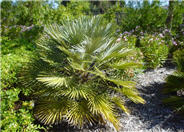
Common name:Mediterranean Fan palm
Botanical name:Chamaerops humilis
Slow growing to 20' tall but very hardy, the Mediterranean Fan palm is clump forming with rich green foliage. It can be used as a good container subject. It does best in full sun or partial shade. Petioles have sharp spines.
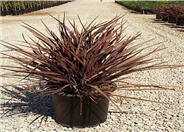
Common name:Amazing Red Flax
Botanical name:Phormium 'Amazing Red'
Phormium 'Amazing Red' is an evergreen perennial. It is a 2' tall, dramatic plant composed of many swordlike, stiffly vertical leaves in a fan pattern. Leaves are dark reddish brown in color.
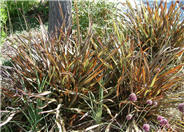
Common name:Jack Spratt Dwarf Flax
Botanical name:Phormium 'Jack Spratt'
Phormium 'Jack Spratt' is an evergreen perennial. This variety is a dwarf, reaching 18" tall and wide. It is fan-shaped and clumping. The leaves are burgundy bronze in color and make a great border plant.

Common name:Ground Cover Rose
Botanical name:Rosa Ground Cover varieties
There are many deciduous, evergreen and semi-deciduous roses that are used as groundcovers, usually reaching 2' in height. They look lovely draping a slope. Rosa groundcovers come in a variety of colors but all need full sun and a moderate amount of water to do well.
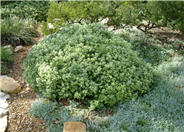
Common name:Compact Karo
Botanical name:Pittosporum crassifolium 'Compactum'
Pittosporum crassifolium 'Nana' is an evergreen shrub or tree. It can reach 25' tall and 20' wide in 8-10 years. Branches are densely clothed in gray green, with 1"-2" long leaves that have rounded ends. It produces maroon flowers in late spring.
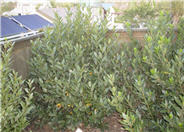
Common name:Saratoga Sweet Bay
Botanical name:Laurus nobilis 'Saratoga'
Laurus nobilis is an evergreen shrub or tree. It grows slowly to 12'-40' tall and wide. The leaves are long and dark green. Clusters of small yellow spring flowers are followed by black or dark purple, .5"-1" long fruit. Leaves may be used in cooking. 'Saratoga' variety is resistant to psyllid, a pest.
| Designer: Susan Mc Eowen | Wall with Water Spouts |
Photographer: GardenSoft |
Soils and Compost:
Practice grass-cycling by leaving short grass clippings on lawns after mowing, so that nutrients and organic matter are returned to the soil.
Water Saving Tip:
Replace turf with groundcovers, trees, and shrubs. If you have areas where no one uses the grass, patches that do not grow well, or a turf area too small to water without runoff, consider replacing the turf with water-efficient landscaping.
Integrated Pest Management:
Remove irrigation water and fertilizer from areas where you don't want weeds to grow.
